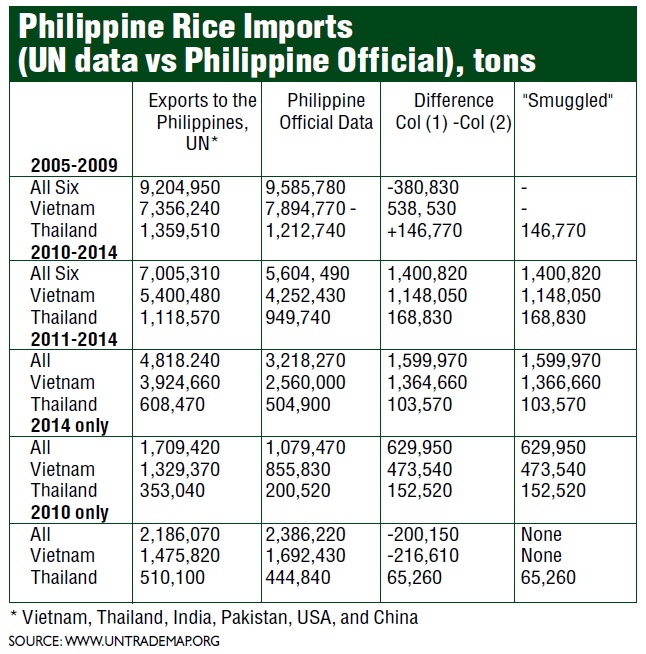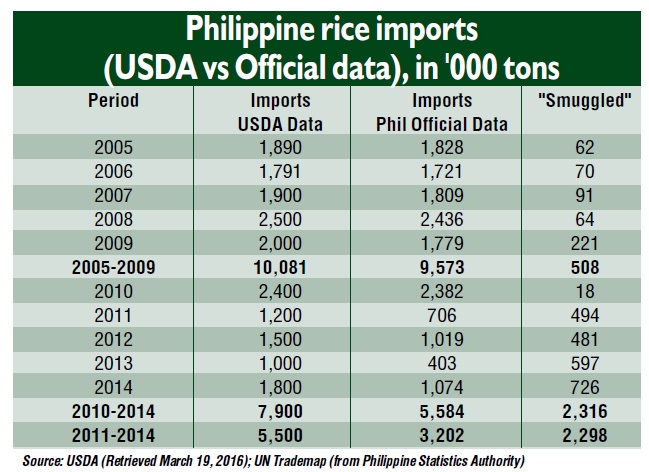Rice smuggling: What is the real score?
THE ISSUE of smuggling keeps popping up in newspaper headlines and television newscasts. The Senate even held a hearing on the subject last Feb. 24.
An industry group claimed some 2,772,142 metric tons of rice were smuggled from 2010 to 2014, double the volume of 1,066,021 tons from 2005 to 2009. It also proposed making the National Food Authority (NFA) the lone importer of rice and for the government to reconsider the implementation of the government-to-government (G2G) scheme as the sole mode of import, as cited in an article in The Manila Times last Feb. 24, 2016.
Rice is a protected commodity. It will be under quantitative restrictions until 2017 and subject to a tariff of 35 percent.
The subject of this column is the huge disparity in data cited by the industry group with the actual data derived from the United Nations (UN) Trade Statistics.
Data from UN websites, specifically www.trademap.org and www.comtrade.un.org, appear to be radically different from the data of the industry group.
Here is the summary of rice trade during the 2010-2014 and 2005-2009 periods. (See Table 1)
Vietnam, Thailand, India, Pakistan, USA, and China are the Philippines’ main supplier of rice. They comprised 99.9 percent of exports to the Philippines in 2014.
The claim by the industry group that 2.77 million tons of rice were smuggled during from 2010 to 2014 period is not supported by the UN statistics, which indicated only 1.60 million tons were “smuggled.” The industry group also claimed around 1.07 million tons were “smuggled” from 2005 to 2009. There was no evidence of large smuggling during the period from international data sources.

The United States Department of Agriculture (USDA) data shows the following imports: (See Table 2)
The disparity between USDA data and Philippine official data shows larger quantities of “smuggling.” From 2005 to 2009, it was 508,000 tons. However, this ballooned to 2,316,000 tons from 2010 to 2014 and most of that occurred during Aquino’s time (2011-2014). The USDA data of 2.32 million of “smuggled” rice appeared “closer” to the said industry group’s estimate of 2.77 million tons.
There was “minimal” smuggling from 2005 to 2009 and in 2010. Based on UN data, large illegal inflows occurred in 2011 to 2014 when about 1.6 million tons of rice entered the country, mostly from Vietnam. Large volumes of smuggling occurred in 2011 (500,000 tons), 2012 (266,000 tons), 2013 (198,000 tons) and 2014 (630,000 tons).
By contrast, based on USDA data, about 500,000 tons of rice were “smuggled” in 2005 to 2009 during the Arroyo administration. These spiked to 2.3 million tons during the period 2011 to 2014.
A former NFA administrator claimed the Philippines has a very porous border, especially in the south bordering Malaysia. At the same time, he said rice was smuggled through major ports as it was not a high value product. Thus, it was highly probable that smugglers were in cahoots with Bureau of Customs personnel.
There is a need to harmonize statistics from various sources in order to have a better basis for policy decisions.
(The article does not reflect the official stand of the Management Association of the Philippines or MAP. Feedback at <map@map.org.ph> and <rdyster@gmail.com>. For previous articles, please visit )
